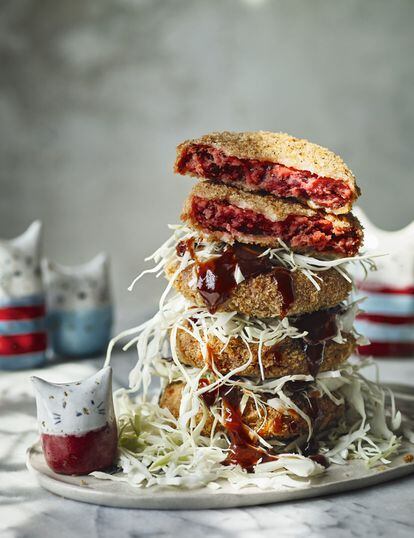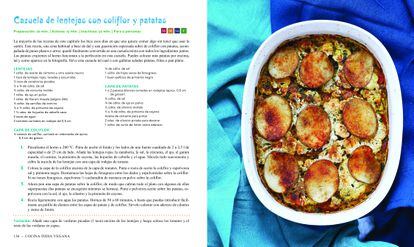In recent years, bookstores have echoed one of the food trends: veganism. References and readers have multiplied, and so have views on what and how to maintain a diet according to vegan guidelines. Today, if we look at the shelf of vegan kitchens, we could go around the world, thus breaking one of the common beliefs that veganism is boring and monotonous. Whether we are vegan or not, here are four references that invite us to open our minds:
“Being vegan is someone who does not consume any product that comes from animal exploitation. Vegans do not wear fur or leather, do not buy cosmetics or household products that contain animal materials or that have been tested on animals, and do not go to shows that exploit animals, such as bullfights, zoos, or theaters. circuses with animals”, writes Marie Laforêt in The Big Book of French Vegan Cooking (Beta publishing house). Then the question arises: what is vegan cuisine? And it answers itself with “it is as diverse and varied as food in general, since all the recipes in the world can potentially be 'veganized' (…) Dishes that adjust to the seasons of the year with vegetables and ingredients organic”. This is how it begins, and continues with “this book aims to offer recipes that everyone likes and that serve to ensure that family gatherings are no longer a headache or a source of anxiety, but rather a time when everyone can taste the same dish!” . To do this, she proposes everything from different dishes filled with soy to fresh and creamy cheeses made with vegetable milks such as ricotta or soy mozzarella; raw sprouted lentil meatballs or raw lasagna with zucchini, walnuts and tomatoes, for example.

Of course, Maire Laforêt introduces us to that universe with her motto of “everything can be converted into vegan food” in the same way that chef Tim Anderson does in Vegan Japaneasy. Japanese vegan recipes to prepare at home, edited by Cúpula. The author, owner of the Japanese home cooking restaurant Nanban (London) and author of wonderful books such as Tokyo Stories (Cinco Tintas publishing house) created this book inspired by his trips to Japan. “Japan is not a particularly suitable place for vegans (…) but what I did learn is how great Japanese condiments are, and how to combine and layer them to magically create much more satisfying meals, with or without meat (… ) when you have such fantastic, tasty ingredients at your disposal—things like bitter misothe salty mushrooms shiitake or ponzu acid, to name a few—Who needs Meat?” The book, in hardcover, tempts even those who do not even remotely pretend to be vegan in their life. Nassima Rothacker's photographs are attractive and the recipes are original: crispy fried eggplant with miso spicy; sweet potato roll with ponzu, katsu —said to be a breaded and fried ingredient that usually has a sauce on top— of cauliflower with curry; or pesto udon, to cite a few examples. As a final attraction, the book ends with a suggestion to prepare a luxury vegan bento to take to work and with a very tempting combination proposal: sake and watermelon mojito, brandy and green tea granita or the Bloody Mariko, Japanese version of the bloody mary traditional, the difference? It is always in the use of wasabi.
If there is a gastronomic culture that can boast of being vegetarian and, by extension, having every possibility of converting to veganism, it is India. Among the many examples that you can find of Indian cuisines for vegans, stands out Vegan Indian Cuisine. Traditional and creative recipes to prepare at home, by blogger Richa Hingle (Gaia publishing house). In the presentation of the book where the writer tells how and why she became vegan, she explains that “Indian food is almost vegetarian: rich in vegetables, it does not depend excessively on cheese or meat.” In the volume there are 150 recipes inspired by the different regional cuisines of India, its culture, local foods and its cooking methods for any part of the day: from the first bite with tofu scrambled with South Indian spices to a curry of red beans, a pulao red lentils with tomato or a tempeh and cauliflower in yogurt and hot paprika sauce, for example. As an addition, it teaches how to prepare traditional breads and a few desserts with a lot of Hindu seal.

Speaking of desserts, is there a vegan pastry shop? The answer is yes. According to Toni Rodríguez, pastry chef, creator of the first vegan pastry shop in Europe, Lujuria Vegana (Barcelona) and author of the book Vegan Pastry School (Editorial Larousse): “it is a type of pastry in which no ingredient that comes from animal origin or exploitation is used (…) There are many 100% vegetable ingredients that are usually used in traditional pastry.” Then it is possible to make vegan cakes giving greater prominence to nuts, using water or soy milk as a liquid base, working with fruits, pure chocolate, natural essences. The book, which features excellent photographs of Becky Lawton, never ceases to surprise, tempt and seduce: millefeuille with caramelized sugar and vanilla; crostata filled with homemade jam, lemon pie based on almonds, lemon and coconut oil; or a plaisir sucré with hazelnuts, chocolate and soy milk. A gem full of ideas for the sweetest vegans.
#Vegan #cuisine #surprise #skeptics